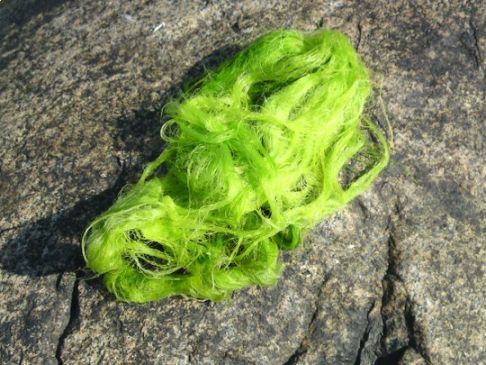The unwanted coating of Cladophora algae, common in the Baltic Sea and other regions of the world, could be used as an effective coating material for environmentally friendly batteries

An unwanted cover of Cladophora algae, which is common in the Baltic Sea and other regions of the world, is not without its benefits. A team of researchers from a university in Sweden (Uppsala) discovered that the unique cellular nanostructure of this algae could be used as an effective coating material for environmentally friendly batteries.
The research findings were published in the scientific journal Nano Letters. "This algae has a special cellular structure characterized by a very large surface area," says researcher Gustav Nyström, who is the first author of this article. "By coating the structure with a thin layer of conductive polymer, we were able to produce an electric battery that weighs little and which achieved new records of charging time and capacity for polymer-cellulosic batteries."
Despite extensive efforts made in recent years to develop novel cellulose-based coating materials for battery applications, it has been shown that the ability to obtain satisfactory charging performance has been limited. However, no one has tried to use cellulose derived from algae. Researchers from the Department of Engineering Sciences at Uppsala University in Sweden have been studying the possible pharmaceutical applications of cellulose derived from the green algae Cladophora for several years. This type of cellulose has a unique nanostructure, completely different from that found in terrestrial plants, and it has been proven that it functions well as a thickening agent in pharmaceutical preparations and as a binder in food products. Its possible ability to be used in energy storage applications was born from its large surface area.
"For a long time we have been hoping to find a practical application for the material derived from the algae mantle and now we have demonstrated that this is possible," explains researcher Maria Strømme, professor of nanotechnology and head of the research group. "The battery research has a real interdisciplinary character and was carried out in collaboration with chemistry professor Leif Nyholm. Cellulose preparation experts, chemists engaged in battery research and nanotechnology scientists - all together played vital roles in the development of the new material."
The research findings, in fact, present for the first time a completely new material for electrodes that will be used in the fields of energy storage, a material consisting of a nanostructure of algae cellulose coated with a polypyrrole layer that is only fifty nanometers thick. Batteries based on this material can store up to six hundred milliamperes per cc, with a loss of only six percent of this capacity after one hundred charging cycles."
"The research results provide new possibilities for the mass production of environmentally friendly, cheap and light-weight energy storage systems," the researchers explain.

5 תגובות
Cellulose is the material that covers the plant,
As far as I understand, the material is used in the battery body.
The coating of the acceleration will be used to build the battery itself
The title is misleading
The article states:
"Effective coating material for environmentally friendly batteries."
And it's not exactly "paper batteries from green algae"
The whole thing is that maybe it will be a coating.
It is good to attract the readers but there is a limit
We urgently need non-polluting batteries because more and more car manufacturers are switching to producing electric cars and it's only a matter of time until it picks up speed and everyone will buy electric cars especially because of the low taxation and if they use the old batteries it can create serious pollution.
It is interesting to know that Google also invests a lot of resources in this.
You can read about it on their energy blog.
øøøøøøøøøøøøøøøøøøøøøøøøøøø